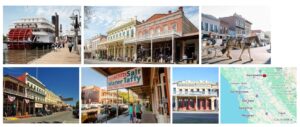Wow Place #287: Old Sacramento, CA
Not long ago, I was walking through the Higashiyama district of Kyoto, Japan – with its classic, wooden houses and traditional tea shops — thinking, “This looks just like the set of a Kurosawa samurai movie.” Is it touristy? Of course it is. Are there entirely too many gift shops and tchotchke vendors? Alas yes. But it’s still pretty wonderful.
That’s the same feeling I get while touring Old Sacramento, CA — a little slice of the American West. With its wooden sidewalks, mid-Nineteenth Century architecture and ever-present saloons, I can easily imagine cowboys with spurs sidling down these street, twirling their moustaches, looking for a shot of whiskey, a game of poker, or better yet, a bar fight.
What makes both locations so interesting and so contradictory is that they ARE, in fact, authentic, historical locations. A city planner didn’t just say, “Let’s build a theme park here that recreates the Samurai Era” or “Let’s construct a place that looks and feels like the Wild West.” These locations are the real McCoys.

Take Old Sacramento, for example. It was just a few miles away that James Marshall discovered gold at John Sutter’s mill in 1948, setting off one of the greatest gold rushes the world has ever seen. Ready for the moment, local merchant San Brannon rushed to open a store near the Sacramento River that would serve as a trading center for miners outfitting themselves for the gold fields. (Note: only a relatively few miners actually got rich from the Gold Rush, while Brannon earned himself a fortune.)
The Sacramento waterfront saw its ups and downs over the years, from fires to floods to, eventually, economic decline as the commercial district gradually moved east. By the 1900s, Old Sacramento – with its classic Old-West buildings and wooden streets – had become known as the worst skid row west of Chicago. It wasn’t until the mid-1960s that a plan was set forth to redevelop the area, highlighting the district’s 53 historic buildings. Today, the waterfront area is a bustling, thriving area of shops, restaurants, and tourist attractions, at once kitschy and at the same preserving that old-cowboy feeling of Deadwood and the Ok Corral.
For me, touristy places like Kyoto and Old Sac raise the question: “Should I visit here?” I mean, can you really transport yourself back in time when the place looks historical but still sports a Starbucks and an Arby’s? I have to admit that those 15 drunken bachelorettes weaving down the street, each wearing sashes and crowns, sort of takes me out of the moment.
The trick for visiting places like this is to arrive early, at the crack of dawn, well before the tourists take over the streets. That’s when Old Kyoto penetrates the veil of history. That’s when you can hear the patter of horse footsteps on the streets of Sacramento…when you can smell sawdust and gunpowder in the air. The ghosts of the Old West still walk along the streets of the Sacramento waterfront if you have the patience and the imagination to look for them.
And chances are they’re not drinking Venti Frappuccinos either.
(A common rejoinder I often hear from travelers on the road is, “I came here years ago and it used to be great. Now it’s ‘spoiled.’” Have you ever heard this? I wonder though, is it really the place that’s ruined, or is it our attitude about the place that’s the culprit? Things change. Local merchants need to make money. Does a place really need to stay pure, authentic and poor – all for your pleasure? Or, can it be allowed to evolve and prosper economically, even if that means submitting to modern, mercantile influences. Is the Roman Colosseum any less enjoyable if it has cell phone charging stations? It’s the same with our loved ones. Sure, we liked the way they used to be. But our job is not to stunt their growth, like fixing insects in amber; our task is to nurture our loved ones’ evolution, and appreciate them for however they change and grow. Like Kyoto and Sacramento. Everything is a process.)
